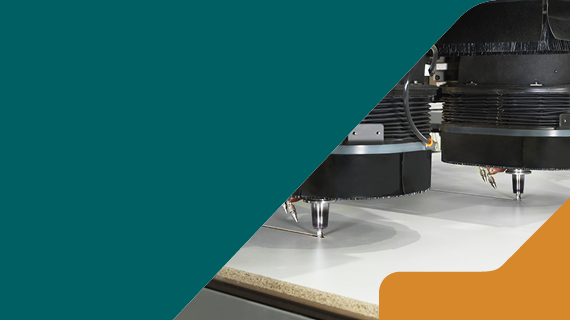
The nesting process consists of cutting and boring panels using cylindrical tools, standard-end cutters, with a solid-table machining centre.
The advantage of nesting processes lies in the fact that they enable the largest number of parts to be obtained from a single large piece, whilst producing the lowest amount of scrap. As a result, the greater the number of different the dimensions of the parts to be machined, the more efficient the nesting process.
Biesse solutions for nesting technology
Stand-alone solutions are nesting machines that require the operator to manually load the sheet into the machine. These solutions have become less common in recent years, due to the fact that as market demands evolve, increasingly automated solutions are required.
These stand-alone solutions can be combined with an unloading belt, once the machine has completed the nesting process, it unloads the processed parts along the unloading conveyor with a specific device designed for this purpose. The operator stands at the bottom of the belt to place the products delivered onto the pallet, thus reducing his/her workload.
In nesting cells, the work cycle is fully automated: in other words, the loading of the sheet onto the machine is carried out automatically by the machine itself. The loading pallet is a fully automated pallet which also manages the alignment of the sheet in the X and Y axes, ensuring that the sheet entering the machine is perfectly aligned with the rear stops of the machine.
Nesting cell solutions can also be integrated with automatic loading and unloading systems: ROS, for example.
Characteristics of the nesting process
There are many factors that can cause production errors in the nesting process. As such, it is important to prevent these through technical solutions that can be adopted on the machines. In light of this, Biesse has introduced a dynamic vacuum system: this allows the machine to concentrate the majority of the vacuum power on where the tool is cutting, through the dynamic management of the vacuum pumps. This represents a major advantage when it comes to processing small parts.
Another aspect that affects the processing speed and prevents errors is the blower. The blower facilitates the loading of the sheet onto the machine, reducing the friction between the main panel and the support panel. This prevents scratches on the underside of the panel. Meanwhile, the pressure rollers increase the hold of the pieces on the work table, particularly in the case of pack machining; these also serve to speed up the process, thus serving a very important purpose.
